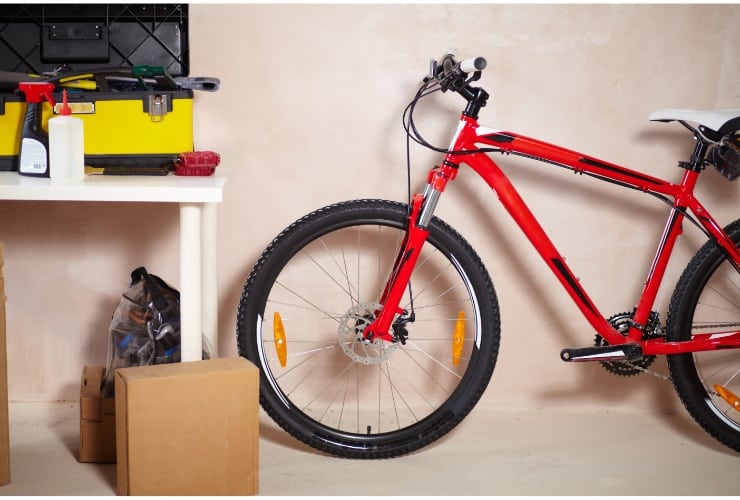A typical bike will last anywhere from five to ten years or up to 50,000 miles. If you bike every day, expect its lifetime to be around five years; if you don’t, it may last 10+ years.
However, many factors will determine the longevity of your bike. This article will review the lifespan of the many different parts of your bicycle and will give a few tips to increase longevity.
Key Takeaways
- The lifespan of your bike depends on several factors like quality, type, miles, terrain, and maintenance.
- You should replace some bike parts regularly, such as tires, brake pads, chains, cables, and bearings, to prevent damage and improve performance.
- Carbon fiber and titanium frames can last longer than steel and aluminum frames, but they are also more expensive.
- You should clean, inspect, grease, and lubricate your bike frequently to keep it in good condition.
- You should also store your bike in a dry and protected place to avoid exposure to the elements that can cause rust and deterioration.
How Many Miles Do Bicycle Tires Last?
While your bike may last up to ten years, don’t expect your tires to do the same. Much like other bike parts, tires have a limited life cycle of about 800 to 3500 miles. The number of miles bike tires last will depend on the type of tire you have.
- Racing tires. These types of tires are typically much lighter than their counterparts; they will last anywhere from 800 to 1000 miles.
- Mountain bike tires. Mountain bikes get the most wear and tear due to rough terrain. Even though the tires are heavy-duty, you will need to replace them every 500 to 1000 miles as the grip may wear down. (Riding with worn-out tires is dangerous, especially on mountain trails.)
- Road tires. Since these tires mainly stick to paved roads, they can last anywhere from 1000 miles to 3000 miles.
How Long Do Bicycle Brake Pads Last?
One of the main, overlooked bike components is your brake pads. This component belongs to the bike’s brake system and determines how responsive the system is and how well the brakes work in wet conditions.
Generally speaking, brake pads last 500 to 1000 miles and should be replaced regularly. However, it’s best to check them often (at least once a month), as letting them wear out can lead to safety hazards.
How Often Do You Need to Change Your Bike Chain?
The bike chain is another fundamental part that you need to replace eventually. Typically, bike chains can last up to 3,000 miles.
An easy way to check if your chain needs replacing is to see how much it has stretched. You can do this with a ruler or buy a chain checker tool.
How Many Miles Do Bike Bearings Last?
Unlike most other components, your bike bearings can last much longer before needing a replacement. Bearings will generally last up to 50,000 miles, the low end being 25,000 miles.
In terms of months, bearings can last anywhere from 12 months to three years, depending on how much you ride. As with any other bike component, it is best to keep an eye on them to assess them for wear and tear and to make sure they’re still in gopod condition. The video below is a good example of what to look out for.
How Long Do Bike Cables Last?
Bike cables are part of the brake system and typically last around 3,000 miles or three years. Everyday wear and tear can cause these cables to break down and eventually affect how well the brake system works.
You will know you need to replace your brake cables when the cables feel sticky or sluggish when you try to brake.
You can also inspect the cables and make sure there is no fraying, cracks, or discoloration. If you notice any of these things, it’s time for a replacement.
What Bike Frame Material Lasts the Longest?
The type of material your bike frame is made of will affect your bike’s longevity. So which material lasts the longest: carbon fiber, aluminum, steel, or titanium?
Carbon Fiber
If you’re wondering what frame will last the longest, carbon fiber frames will be the winner. While other frames may offer more strength, carbon fiber can theoretically last forever. Unlike metal, this frame material won’t fatigue, wear down, or rust.
The one downside of a carbon frame is that it will be expensive. However, many cyclists believe these high-quality bike frames are worth the high price, as it is more of a long term investment.
Steel
Unlike carbon fiber, steel frames will have an expiration date. While steel bike frames are considered the strongest, the typical lifespan is five to ten years. One of the main things to watch out for with these frames is rust.
However, if properly maintained and stored, you can push a steel frame to last longer than ten years.
Aluminum
Many cyclists prefer aluminum frames over other frame materials, as they are lightweight and affordable. Unfortunately, compared to competitors, aluminum bikes are not nearly as strong, which lowers their longevity.
Similar to steel frames, aluminum bikes can last five to ten years. However, they are more likely to last on the lower end of the spectrum.
Titanium
Similar to carbon bikes, your typical titanium frame can outlast most riders. With the strength of steel and anti-corrosive properties, a titanium bicycle would be a smart choice if you want a strong frame.
One downside of this long-lasting material is that it is expensive since it is more challenging to source. However, since it could last essentially forever, the price may be worth it.

Factors That Affect the Lifespan of Bikes
From riding style to quality, several factors will affect your bike’s lifespan. This section will review how a few factors, like quality, type of bike, miles, and terrain, can lower the longevity of your bicycle. Let’s get into it.
The Bike’s Overall Quality
It’s not hard to figure out that inexpensive bikes may not last as long. While it doesn’t take much to find a good bike (generally, you’d expect anything over $500 should be good quality, but remember that price and quality do not always show direct correlation), many stores offer bikes in the $100 to $500 range that won’t last as long.
When buying a lower-quality bike, you may find that the bike was not assembled properly or that manufacturers used lower-quality internal parts. Due to these reasons, a lower-quality bike may only last around 5,000 miles.
The Type of Bike
While many factors determine how long your bicycle lasts, something worth considering is the type of bike you have.
Typically, bikes meant for rougher terrain, like mountain bikes, will last longer. All of the components on bikes like these are heavier-duty compared to components on a lighter road bike, for instance.
Miles Travelled
A more obvious factor that will affect the longevity of your bike is the number of miles you ride. If you are a more casual rider, your bike will last longer than a cyclist who rides 5,000 miles a year.
If you use your bike for commuting or daily exercise, the bike will be more susceptible to wear and tear and may not last as long.
The Terrain You Ride On
Another factor that will affect lifespan is riding conditions. For instance, taking your bike to the mountains every weekend will expose it to harsher conditions.
While mountain bikes are meant for that type of terrain, you are more likely to fall or crash on these types of trails, which can cause damage to the frame.
Not only does this rule apply to mountain bikes, but taking hybrid or road bikes, for example, on harsh gravel roads or backwoods trails, will decrease their lifespan.

How to Extend the Lifespan of Your Bike
After reading the previous section, you may feel a bit discouraged as there are many factors that can lower the lifespan of your bicycle. Fortunately, there are also several ways you can extend its life.
From regular maintenance to proper storage, I will list a few simple and easy ways to help your bike last forever (okay, maybe not forever, but for a long time!).
Perform Regular Bike Maintenance
Regular maintenance is critical for extending the life of your bike. Even if you have an old bike, you will be surprised at how proper maintenance can impact performance.
Here are a few easy ways you can maintain your bike:
- Clean your bike. A well-maintained bike is a clean bike. Make sure to clean your bike regularly, whether that means every few rides or every few months. (It all depends on how much you ride.) Two easy ways to clean your bike are with a hose or a bucket of water. You can also wipe it down with a washcloth.
- Inspect the bike. To give your bike proper care, make sure to inspect it on a regular basis. Bike frames can take a lot of damage, and if you don’t look closely, you might not notice until it’s too late. Keep an eye on the joints near the bottom bracket and head tube, and take it into the shop if you notice any damage, even if it’s small.
- Grease and lubricate your bike. To keep your bike running smooth, make sure to lubricate and grease it. This will help prevent damage from everyday wear and tear. If you are unsure how to do this, you can have it regularly serviced at your local bike shop, and they will take care of it.
- Ride in clean conditions. If you use a bike to commute, this may not be the easiest thing to do. However, if you have the option, try to ride in clean conditions. Avoiding muddy roads and rainy weather will help keep your bike clean and prevent wear.
Replace Parts Before They Break
Fortunately, you don’t have to buy a new bike every time one of the parts wears down. Decent bike frames will typically outlast most bike parts, so you will need to keep an eye on how the different components are doing.
As mentioned above, you will need to replace parts such as tires, brake pads, bike chains, cables, and bearings. Replacing these parts will boost your bike’s performance and longevity and prevent irreversible damage.
While I have provided good guidelines above, not every bike will be the same. There are a few factors that will determine when you need to replace parts, such as the kind of bike you have and how much you ride. Keep this in mind when thinking of replacing parts.
Proper Bike Storage

It is easy to overlook certain factors of caring for your bike, such as storage. Not only can it be difficult to find an ideal place for it, but it can be annoying lugging it around after your ride.
However, making sure your bike is stored properly is the key to a long life. Elements such as water, dirt, and sun can damage your bike. Furthermore, humid climates can also cause rust to develop on the frames. From carbon frames to aluminum bike frames, the weather will cause irreversible damage to all types of bikes.
Ideally, you should have a dry place to put your bike that is protected from the elements. Somewhere in your home, garage, or even a shed outside would do.
There are several storage options you can use, including free-standing racks, wall mounts, or ceiling mounts.
Conclusion
A well-maintained bike can last anywhere from five to ten years. If you perform regular maintenance and store your bike properly, it can last longer than ten years.
However, you will need to replace most components at some point in your cycling career. More delicate components like the tires and brake pads need to be replaced every 800 miles or so, while you can replace bike bearings every few years.
Be sure to share and comment on this article if you enjoyed it, and tell us any tips you have on helping your bike last long!

